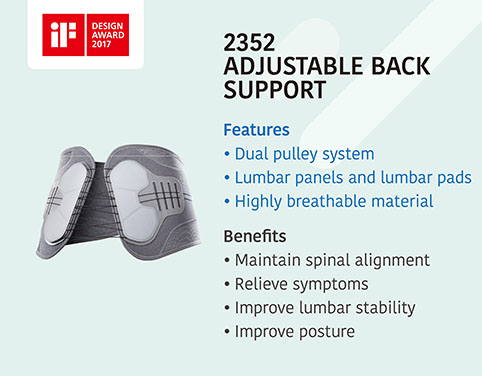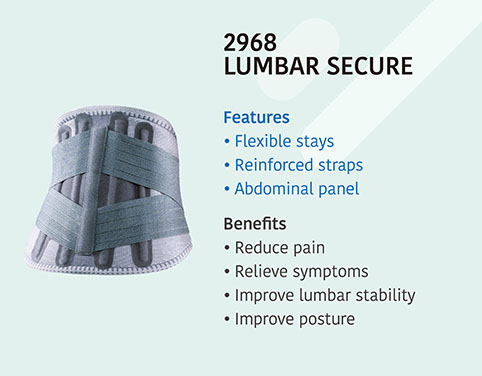LOADING
Low back pain is a frequent condition that can limit movement, reduce comfort, and interfere with daily activities. It often develops from muscle strain, poor posture, or spinal changes, and may lead to stiffness, spasms, and difficulty in mobility. This article outlines the common symptoms and causes of low back pain, and explores how lumbar supports can provide targeted relief, promote better posture, and assist in restoring functional movement.
Low back pain is a common condition that affects millions of people worldwide. It is characterized by discomfort or pain in the lower back area, which can range from mild to severe. Low back pain can occur due to a variety of reasons including muscle strain, poor posture, herniated discs, arthritis, and degenerative disc disease. It is one of the leading causes of disability and can significantly impact daily activities and overall quality of life.
Assessment Checklist:
▢ Is there a persistent ache or stiffness in the lower back?
▢ Is the pain worse after sitting or standing for long periods?
▢ Is there sharp pain after lifting heavy objects or twisting the back?
▢ Is the pain radiating down into the legs or buttocks?
▢ Is it difficult to move or stand up straight?
▢ Is back pain affecting sleep or daily activities?
If three or more of the above symptoms are present, it may indicate low back pain. It is advisable to consult a healthcare professional for further evaluation and guidance. In addition to seeking medical assistance, wearing lumbar supports in daily life can alleviate various discomforts caused by low back pain. Benefits include easing back pain, boosting mobility, strengthening weakened muscles, and maintaining proper alignment.
Pain
Pain is the most common symptom of low back pain, often intensifying with movement or prolonged sitting. This discomfort can interfere with daily activities like walking, bending, and lifting, leading to reliance on pain medications and decreased quality of life.
Stiffness and Muscle Spasm
Stiffness and muscle spasms often occur after prolonged inactivity or overexertion. These symptoms can make movement difficult, especially in the morning or after sitting for long periods. Daily activities like bending, lifting, or reaching become challenging, making simple tasks such as getting out of bed or standing up from a chair uncomfortable.
Difficulty in Movement
Difficulty in movement results in limited mobility and flexibility with low back pain. Patients may struggle with bending, twisting, or lifting, leading to reduced physical activity and overall fitness, potentially causing muscle weakness and exacerbating the problem.

A. Lumbar Panels and Lumbar Pads
The lumbar panels and pads stabilize the lumbar area and reduce pain from excessive movements by providing consistent support during daily activities. This support extends from the lumbar column (L1-5) to the sacrum and side muscles, promoting better posture and reducing pressure on sensitive areas. By alleviating stiffness and muscle spasms, these features enhance lower back stability, maintain proper posture, and reduce movement difficulties. This design allows for greater mobility and flexibility, easing bending, twisting, or lifting while effectively addressing common issues, including discomfort and stiffness.
C. Dual Pulley System
The dual pulley system allows for customized compression and support, helping to alleviate pain by delivering necessary support to the lumbar spine and pelvis, thereby reducing strain on muscles and ligaments. This precise and tailored compression ensures the brace fits snugly and provides consistent pressure, which not only alleviates stiffness and muscle spasms but also relaxes tense muscles and reduces the frequency of spasms.
D. Highly Breathable Material
The breathable and durable material offers strong support while ensuring comfort during long-term wear, promoting better movement and flexibility, and improving overall mobility.

A. Flexible Stays
The four flexible stays provide concentrated support to the lumbar-sacral area, stabilizing the lower back and reducing movements that can aggravate pain. This adaptable support can ease stiffness by maintaining proper spinal alignment and reducing muscle strain, which helps prevent muscle spasms by allowing muscles to relax. By providing support and stabilization, the flexible stays reduce the risk of further injury and allow for safer movement, helping patients perform daily activities with less difficulty.
B. Reinforced Straps
The reinforced straps allow for adjustable compression, supporting core muscles and providing a snug fit. This compression reduces pain by improving posture and alignment, alleviating stress on the affected area, and offering relief during activities. Additionally, the adjustable compression enhances blood flow and helps reduce stiffness and muscle spasms by maintaining proper support and alignment.
C. Abdominal Panel
The abdominal panel, combined with the reinforced straps, provides intra-abdominal compression, helping to correct posture and reduce strain on the lower back, thereby decreasing pain. This posture-correcting support keeps the spine aligned during movement, making it easier to bend, lift, and twist while reducing strain.


Copy Link